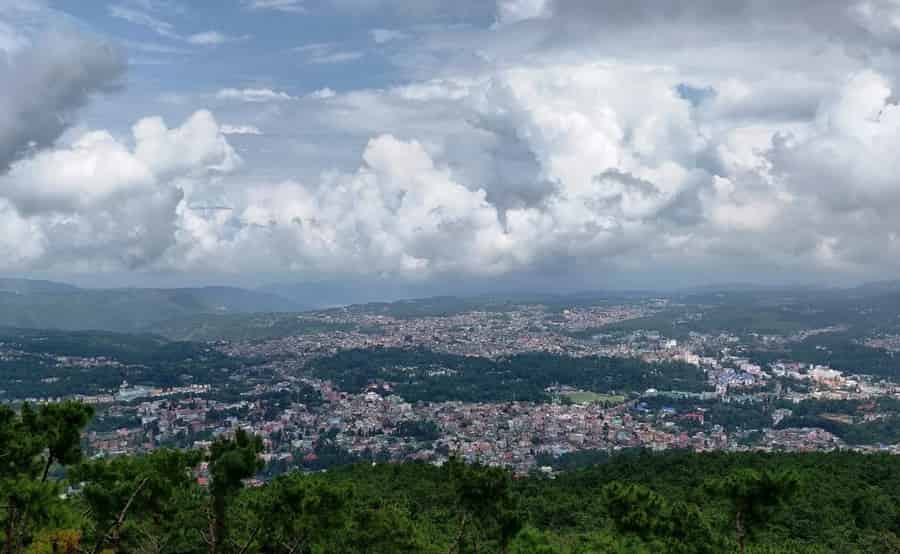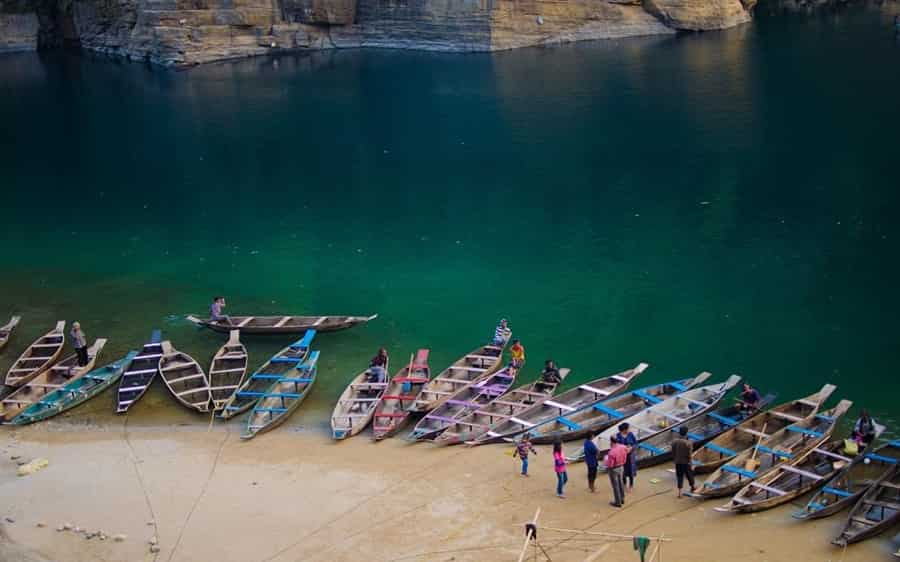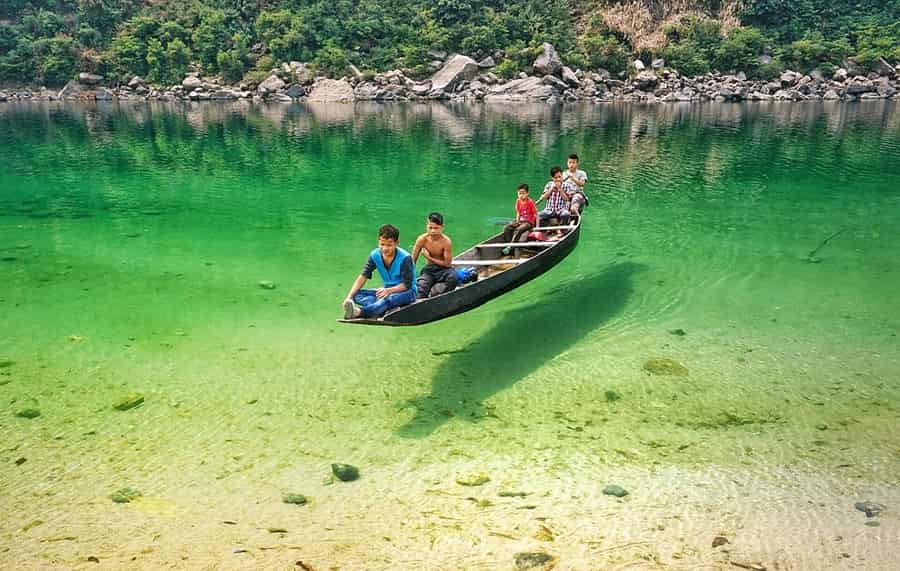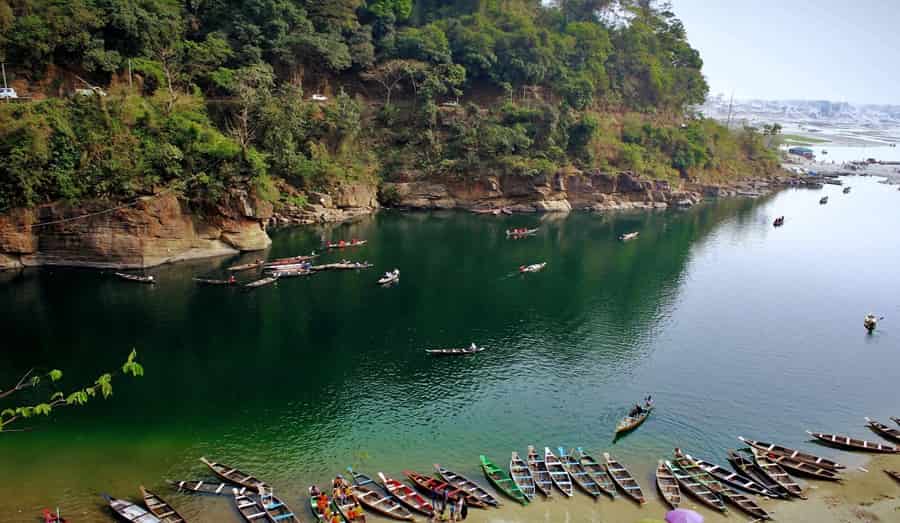Last Updated on March 10, 2025
An Experience to Cherish in Dawki Village of Meghalaya
Umngot River in Dawki Village, that was all I had in my mind when I was rushing to the office of Meghalaya Tourism Corporation in Shillong. We were just concluding our conducted tour to Cherrapunji, but what I needed then was was a confirmation about the next day’s trip to Dawki. Unfortunately, we were only five with a desire to make it to the village that hosts the crystal clear waters of Umngot River.
Mostly guests were interested to visit Cherrapunji and Shillong. Realizing the need for a campaign to be executed for getting more guests to Dawki (Meghalaya Tourism Officials needed atleast 10 travelers to operate a but towards Dawki), we decided to canvas tourists for the state tourism corporation. A long 2 hours of campaigning helped us to fill the minimum numbers for the next days Dawki Trip.

Shillong to Dawki, the journey begins
Though I was a bit lazy in the morning next day, as we started off through the vibrant and lovely nature of Meghalaya, I was refreshed and in mood. After almost an hour we stopped at an exotic location that was lush green and so dark.
The Deep Dark Valley or the Rngain Canyon amazed me with its thick vegetation and strikingly captivating hillocks. The valley proved the name – Deep Dark Valley, by its abundance of flora. It was being a sunny day during the early winter, I could make it to the deep depths of the valley, but respecting the norms of a conducted group tour, I decided to take some snaps and continue with the team towards Dawki Village.

A walk through the living root bridge
After the Deep Dark Valley, we continued through the curvy roads with golden yellow meadows on both sides. The early days of winter had already changed the colors of grasses and even the land. We must have traveled for almost thirty minutes or at the most an hour, the bus started to run through a subtropical forest. There the plants were thick and stood closer to the roads. A large colony of plants that resembled the papyrus leaves of Africa thrilled me. Bobbing and swaying on the we finally reached at the parking space of Riwai.
Riwai village was unique by its look and feel. Several small paths leading to different slopes of the same hill. Small kiosks selling vegetables, fruits and handicrafts. We took the path that followed the sign of living root bridge. A walk of 10 minutes beneath the tall and spreading trees led us to a lean yet whispering stream. Over the stream was a bridge made out of wild rubber roots – the living root bridge. Meghalaya owns several of these living root bridges, but this one is considered the easiest to access.

I walked over the bridge and reached down to the stream for a relaxing touch. The waters giggled and spattered as it flow over the stones and burrows of rocks. I cupped a handful of clear water and splashed it on my face. Cold, and fresh! So natural and enthralling the experience around the living root bridge of Riwai village.
Mawlynnong, the cleanest Asian village
Riwai village was clean and neat, but not very far from there was Mawlynnong – the cleanest among the Asian villages. We were awestruck by the serenity and freshness. An undiluted beauty of an Indian rural destination blended with the vibrant greenish environment captured our mind and senses. Of course, we walked around the village that hosts some of the narrow, yet elegant paths. Some of the tourists though littered a few toffee wraps, the villagers picked them quickly and disposed them to the waste bins kept along the paths.
I was falling in love with Meghalaya and its allure. Things got spiced up when we sat down to enjoy our meal in a village restaurant. I decided to go purely vegetarian with fresh okra, lentil soup, salads, and vegetable curry. One of my best meal ever in my life with no added spices other than ginger, garlic, and green chillies.
Dawki, the village that borders to Bangladesh

After our visit to Mawlynnong, we moved on towards the mystical river Umngot. Our journey to Dawki was through the green wild forests. The abundance of nature and freshness of air surely charmed us. The village was an exceptional beauty with the gorgeously clear brook. Yet an interesting fact was that it shared a border with India’s friendly neighbor – Bangladesh.
We got off from the bus and walked down to the bank. There were boatmen waiting to take us around. They never tried to snatch the guests from the co-boatmen. We walked near to the river, and it’s true! We could see the bottom, and it was deep. We spoke to one of the boatmen and took his service for Rs.650.00.
The transparent water, the stunningly cut rocky banks, and the fishermen were all a thrilling experience. A boy who was enjoying the clear water swimming tempted me, but the weather was cold for me to even remove my jacket. We sailed for almost ten minutes to reach a sandy bank. That was the spot to take a flying boat photograph, but we were late. Sunlight is a major factor to create such wonderful images.
There were tents and kayaks for rent. It was getting dark. We walked on the sand for a while, took some snaps, and returned. As the sun departed from that side of the world, it left wonderful colors on the sky and its reflections over the water.
I must have walked a bit closer to the plain lands of Bangladesh, a BSF Jawan stopped me and suggested me to return. I couldn’t see a clear separation between the countries, but of course I had to step back. Our trip to Dawki was almost coming to an end, but I knew that I should visit Meghalaya again. Yet, if you are willing to visit Dawki, there are a few things that you need to know.
Dawki is a village that is easily accessible from Shillong. You can book a cab which may cost you around Indian Rupees 3000.00 to 4000.00.
A cheaper option is to go by Meghalaya Tourism’s conducted Tour. This may cost you just around 600.00 Indian Rupees.
There are facilities to tent camp in Dawki, on the banks of river Umngot.
You will better enjoy Dawki, if you reach there before noon.
Though Mawlynnong, Riwai, and Dawki can be covered on the same day, I would suggest you to spend an whole day in Dawki to adore the changing shades of nature.



